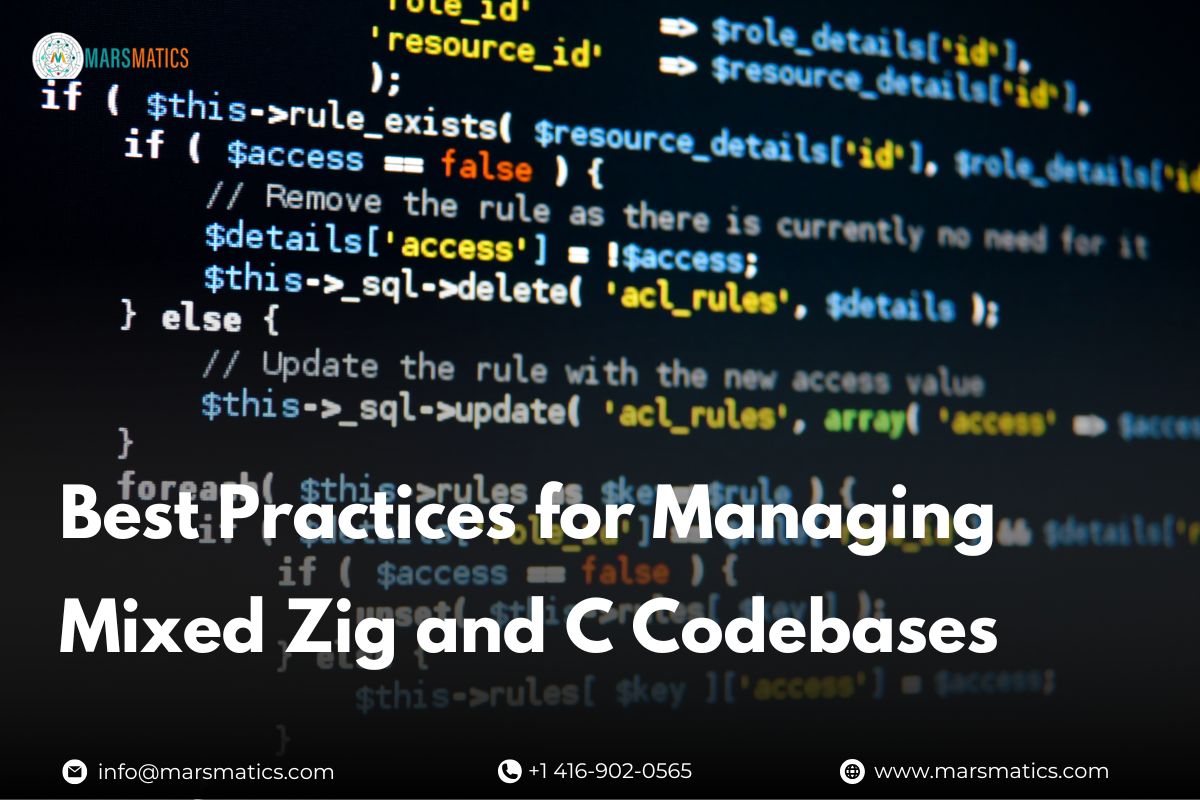Best Practices for Managing Mixed Zig and C Codebases
Combining modern programming languages with legacy code is becoming a necessity for many software teams. With Zig’s rise as a robust systems language, more developers are embracing mixed Zig and C codebases to boost project longevity and maintainability. But how do you do this safely and efficiently? This guide walks you through the best practices for Zig and C interoperability, so you can maximize value from both worlds without losing your sanity.
Also Read: How Zig Lets You Gradually Migrate or Mix C Code Safely?
Why Combine Zig and C in Your Codebase?
Mixing Zig and C might sound complex, but there are compelling reasons to do it:
- Most projects already rely on tried-and-true C libraries. Instead of rewriting everything, you can use Zig’s native compatibility to tap into those resources.
- Rewriting an entire C codebase is often risky, expensive, and time-consuming. Instead, gradual C code migration lets you incrementally move pieces to Zig, reducing risk and spreading out the work.
- Zig was built for seamless integration with C. From calling C functions directly to including header files, Zig and C interoperability is one of Zig’s strongest features.
- Whether you’re seeking better performance, reliability, or portability, mixing Zig and C gives you more control. Zig’s compile-time checks and memory safety features help modernize legacy C code.
Also Read: Zig vs. C: Why Developers Are Exploring Zig for Safer Performance
Setting Up a Mixed Zig and C Project
Proper setup is key to managing Zig and C projects efficiently:
- Keep Zig and C files in clearly separated directories. This makes it easier for teams to navigate, update, and document code.
- Zig’s build system allows you to add C sources and headers with just a few lines. This is crucial for linking C libraries in Zig without headaches.
- Use Zig’s build scripts to manage third-party libraries and dependencies. Properly linking C libraries in Zig ensures everything compiles and runs smoothly.
- Document all interfaces between Zig and C. Use comments and README files to explain how modules interact, so future team members can pick up the project quickly.
Ensuring Safety and Reliability
Safety is a major reason teams move towards Zig. Here’s how to protect your project:
- Zig Safety Features vs C’s Pitfalls: Zig’s type safety, null checks, and bounds checking offer significant advantages over C. When comparing Zig safety features vs C, Zig’s compile-time analysis can catch issues early.
- How Zig Helps Identify and Reduce Memory Bugs in C Code: By wrapping or gradually replacing unsafe C functions with Zig, you reduce the risk of buffer overflows and other memory issues.
- Tools and Techniques: Make use of static analysis tools, linters, and sanitizers for both languages. Regularly run them to catch issues that might slip through code reviews.
Interfacing Zig and C Code Effectively
One of the most powerful aspects of Zig and C interoperability is the Foreign Function Interface (FFI):
- FFI (Foreign Function Interface) in Zig: Basics and Examples: Zig makes it easy to declare and use C functions directly, often by just including the right header.
- Calling C Functions from Zig (and Vice Versa): Whether you’re adding new Zig features to an old C project, or slowly converting functions, FFI enables smooth communication between languages.
- Handling Data Types and Memory Layouts Across Zig and C: Always double-check that data types and struct layouts match on both sides. Mismatches are a common source of bugs.
- Managing Cross-Language Errors and Exceptions: Use clear return values and error handling strategies. Avoid throwing exceptions between C and Zig—use error codes or result types instead.
Maintaining and Evolving Mixed Codebases:
As your codebase evolves, good management becomes critical:
- Version Control Strategies for Mixed Projects: Structure your repository so Zig and C code changes are tracked clearly. Use branches for major migrations or refactors.
- Continuous Integration (CI) and Automated Testing Setups: Set up CI pipelines to build and test both languages together. Automated testing is key to managing Zig and C projects and catching integration issues early.
- Documentation Tips for Cross-Language Teams: Maintain up-to-date docs, especially for FFI interfaces and migration plans. Use code comments generously.
- Planning for Future Migrations: Don’t rush! Gradual C code migration is safer and more sustainable. Create a roadmap for which modules to migrate next, and review progress regularly.
Common Pitfalls and How to Avoid Them
Mixed Zig and C codebases come with unique risks:
- Mismatched Data Types and Memory Errors: Test and review all interfaces between languages to prevent hard-to-find bugs.
- Build System Confusion and Linking Errors: Use Zig’s build system as the primary entry point, and carefully manage how you’re linking C libraries in Zig.
- Over-Reliance on Legacy C Code: Don’t delay migration forever. Plan to gradually replace old C code with Zig where possible.
- Inadequate Testing Across the Zig/C Boundary: Unit test not just individual functions, but also how Zig and C components interact.
Case Studies and Real-World Examples
Looking at real-world successes helps:
- Example of a Successful Zig/C Hybrid Project: Open-source projects and startups have migrated core logic to Zig while still relying on mature C libraries, achieving improved safety and modern features.
- Lessons Learned from Common Migration Mistakes: Teams that tried to migrate all at once often ran into setbacks. Those using Zig C integration best practices—such as incremental migration and strong documentation—report better results.
- Community Tools and Resources for Zig/C Projects: The Zig community has many guides, templates, and build scripts to help with Zig and C interoperability. GitHub and Zig’s official documentation are great starting points.
Conclusion:
To sum up, mixed Zig and C codebases offer a future-proof way to leverage existing investments in C while modernizing with Zig’s safety and simplicity. By following the Zig C integration best practices outlined above, you’ll make managing Zig and C projects easier, safer, and more maintainable.
Remember: take your time with gradual C code migration, prioritize safety, and keep learning from the broader community. The future of systems programming can be both powerful and safe—if you build it right.
FAQs
Q1: Is Zig compatible with all C libraries?
Zig supports most C libraries, but some may require tweaks due to compiler or platform-specific differences. Always test integration thoroughly.
Q2: Can I migrate my entire C project to Zig at once?
While possible, gradual migration is recommended. This reduces risk and allows incremental improvements and testing.
Q3: Does using Zig with C improve performance?
Zig can offer performance benefits, especially with its safety checks and build system, but results depend on code quality and project architecture.
Q4: How do I debug issues across Zig and C code?
Use Zig’s and C’s native debugging tools. Maintain good separation and logging to pinpoint cross-language bugs efficiently.








